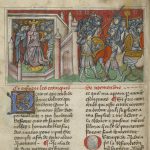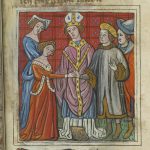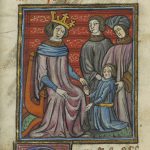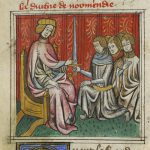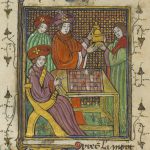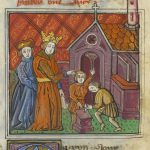Chronicles of Normandy
The text was written between 1350 and 1370 by an anonymous Norman author, probably from Rouen. This story is based on the Roman de Rou of Wace (1160-1174), as well as on the Chronicle of Normandy of the 13th century. The Chronicle focuses on Norman ducal and royal English characters. It begins in 911 with Rollo, the Viking chief, whom the king of France Charles III the Simple donated the County Rouen in the Treaty of Saint -Clair sur Epte. Depending on the version, the story ends either in 1204, with the annexation of Normandy to the crown of France, or at the latest in 1217 with the accession to the English crown of Henry III , son of John Lackland.
The manuscript Y 26 was produced between 1410 and 1420, probably in Parisian circles. After belonging to several owners, it remained for some time in the Abbey of Fecamp fonds before entering the collection of Bigot, great Norman bibliophiles in 17th and 18th centuries, and finally reached the municipal library of Rouen.
The book presents an iconographic cycle of 21 miniatures, each being placed at the head of a chapter opening on the history of a new sovereign. Thus, each Duke of Normandy and King of England is represented in the highest feat of arms or diplomacy. We can see, for example, in folio 12v Scandinavian invasions and the coronation of Rollo, in folio 101 William the Bastard and Matilda of Flanders visiting sites of Caen’s abbeys, or folio 124v the coronation of King Henry II. Note that a part of the images has not been colored .
(text written with courtesy of Mrs Ismérie Triquet
For further reading :
– Labory Gilette, « Les manuscrits de la Grande Chronique de Normandie aux XIVe et XVe siècles », Revue d’histoire de textes, vol. 27 (pp. 191-222), 28 (pp. 183-233) et 29 (pp. 245-294), 1997-1999.
-Triquet Ismérie, Le manuscrit Y 26 de la bibliothèque municipale de Rouen, Mémoire de Master II Histoire de l’art, Université Lille III-Charles de Gaulle, 2006.
- Origin
Fecamp Abbey
- Date details
1410
- Institution
Rouen – Bibliothéque Municipale
- Original reference
MS Y 26
- Period
Middle Ages
- Thematic
Tourism and Culture
Rouen – Bibliothéque Municipale

